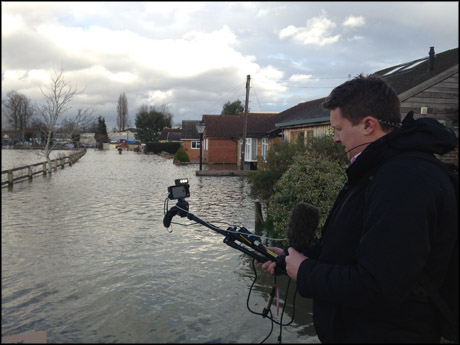
Livestreaming video from a mobile phone is a way for journalists to get footage which may not be possible to film with more traditional broadcast equipment.
"There are sometimes these stories where you don't want a big camera crew, you want to try and keep a relatively low profile, in riots, in public disorder, or in places where you need to be sensitive," Sky News correspondent Nick Martin told Journalism.co.uk.
"You can use that technology which is smaller and more compact to still get what you want to, but not [have] all the big crew considerations that we have."
Media organisations such as ABC News have also started looking at mobile livestreaming as a developing part of their video programming.
For journalists who want to incorporate video streaming into their work, Martin and BBC smartphone trainer Marc Settle shared some tips in a recent Journalism.co.uk podcast
Here are five pointers to get you started.
Stability
The first step to good quality livestreaming is to ensure stability in the shot.
"In its simplest terms, you would hold a mobile phone in your hand and point it at the story and it would be shaky and it would probably look like it was shot by a member of the public," said Martin.
"We can use tripods, or we can mount [iPhones] on Gorillapods and wrap them around lampposts and magnetise them to walls and stick them to cars.
"If you're going down the street and you need to take a steady shot, look around you. Is there a fence panel, is there a post office box, is there a wall that you can rest your phone on to steady that shot?" he added.
Sound
Once the mobile device you're using to record can capture a stable shot, the next point of focus should be the audio.
While the inbuilt microhpone of an iPhone, for example, is usually good enough, if you're planning to live stream interviews or a piece to camera, Marin recommends hooking up a microphone for better sound.

Image from Sky News
For an example of a mobile reporting kit you might find helpful, including audio equipment, have a look at these suggestions from L'Echo journalist Nicolas Bequet.
Connectivity
Being able to get the material you are shooting back to the newsroom is essential, so finding an area with good signal or a coffee shop with Wi-Fi is a must.
Settle said the logistics should be "uppermost in anyone's mind".
"Using an app to see how fast a connection you've got is an absolute no-brainer, you got to make sure that you can get as much speed as you possibly can," he explained.
Martin also pointed out that the more movement there is in a shot, the more data is going to be used, which is another reason why a stable shot is so important.
"Livestreaming over the internet is not easy sometimes, especially when you're limited with signal," he said.
And don't forget to divert your incoming calls to voicemail while livestreaming, as getting a phone call might cause your connection to drop. Here's a guide from the BBC's Nick Garnett for diverting calls on an iPhone.
Be aware of data charges
Settle told Journalism.co.uk that while thinking about good connectivity and how long your phone battery was going to last were important considerations, the amount of data you will be using during a livestream should also be taken into account.
"If you're abroad and you need to do some kind of livestreaming from that great story where you weren't expecting it to happen and you've got your smartphone with you," he said, "you could get through hundreds, possibly thousands of megabytes of data in maybe 20 minutes or half an hour and that could cost you an absolute fortune."
Choose the right apps
Whether livestreaming video or just audio, experiment with apps to find one that works for you.
The BBC has been using an app called Luci Live for audio live streams, "the equivalent of portable ISDN", said Settle. But at around £220 in the App Store, it's one of the more expensive apps.
Report-IT is a cheaper option, and Skype could also be used to livestreaming both video and audio.
For video streaming, Settle recommended Bambuser. But while Skype is "direct livestreaming", Bambuser also records locally on your device.
"If you're using something like Bambuser you're going to be filling up your phone as well at the same time as streaming so that's a consideration," he explained, "because if your phone's already got a lot of extra material on it before long you would have put a whole load of extra megabytes as well."
- To hear more about livestreaming and how it's used by news organisations such as Sky News and ABC News, check out this recent podcast.
Free daily newsletter
If you like our news and feature articles, you can sign up to receive our free daily (Mon-Fri) email newsletter (mobile friendly).
Related articles
- Newsrewired speaker spotlight: Naja Nielsen on innovation, leadership and Nordic media
- Gear, apps and workflows: Rob Layton's complete mobile journalism checklist
- How to listen to people who avoid the news, with Shirish Kulkarni, Abdi Yusuf and Rhiannon White
- Can AI help overcome biases and shortcomings in data journalism?
- Community-led listening project offers solutions to journalism’s biggest challenges











